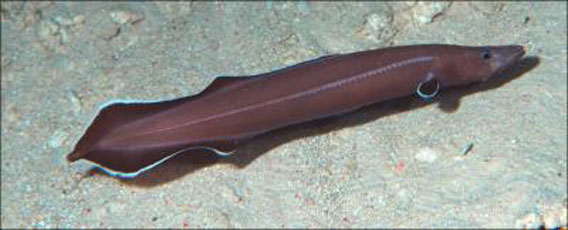
Protoanguilla palau: ‘first eel’. Photo by: Jiro Sakaue.
The ocean holds endless surprises still. In an underwater cave off the Pacific island nation of Palau, reachers have made an astounding discovery: an eel species unknown to science that harkens back 200 million years. The new species, described in the Proceedings of the Royal Society B as an ‘enigmatic, small eel-like fish’, sports anatomical features that differentiate it from the over 800 known species of eel surviving today.
“The equivalent of this primitive eel, in fishes, has perhaps not been seen since the discovery of the coelacanth in the late 1930s,” says Dave Johnson, ichthyologist at the Smithsonian’s National Museum of Natural History and lead author of the team’s research, in a press release. Before its discovery in the 1930s, the coelacanth was only known from fossils dating back 70 million years. However, even the eel fossil record has never shown anything quite like this.
The new species, named Protoanguilla palau, sports a second upper jaw bone and less than 90 vertebrate. These two features have only been seen in fossil eels going going to the Cretaceous. But another feature breaks all the rules: the animal has a complete set of ‘rakers’ in its gill arches, which has only been seen in bony fish, never before in eels either alive or fossilized. To determine its truly relationship to eels and bony fish, the researchers analyzed the animal’s mitochondrial DNA and found that it is a ‘true eel’. The animal likely appeared some 200 million years ago, just at the very end of the Triassic period.
“We believe that such a long, independent evolutionary history, […] retention of several primitive anatomical features and apparently restricted distribution, warrant its recognition as a living fossil,” says Johnson.
The eel’s genus, Protoanguilla, created for this one species, means ‘first eel’.
“The discovery of this extraordinary and beautiful new species of eel underscores how much more there is to learn about our planet,” Johnson adds. “Furthermore, it brings home the critical importance of future conservation efforts—currently this species is known from only 10 specimens collected from a single cave in Palau.”
CITATION: G. David Johnson, Hitoshi Ida, Jiro Sakaue, Tetsuya Sado, Takashi Asahida and Masaki Miya. A ‘living fossil’ eel (Anguilliformes: Protoanguillidae, fam nov) from an undersea cave in Palau. Philosophical Transactions of the Royal Society B, Aug.16, 2011.
Related articles
Photos: 300 species discovered during expedition to Philippines
(06/26/2011) Scientists believe they have discovered more than new 300 species during a six-week expedition to the Philippines.
Photos: the top ten new species discovered in 2010

(05/23/2011) If we had to characterize our understanding of life on Earth as either ignorant or knowledgeable, the former would be most correct. In 250 years of rigorous taxonomic work researchers have cataloged nearly two million species, however scientists estimate the total number of species on Earth is at least five million and perhaps up to a hundred million. This means every year thousands of new species are discovered by researchers, and from these thousands, the International Institute for Species Exploration at Arizona State University selects ten especially notable new species.
Photos: weird new species discovered in deep sea trench

(10/18/2010) Fish were not expected to be able to survive so deep, but scientists have captured footage of a new species of a scavenger-hunting snailfish swimming at an astounding 7,000 meters below the surface. The video, taken from an 8,000 meter-deep sea trench in the Southeast Pacific Ocean, showed a level of biodiversity that surprised seasoned marine biologist, who have previously surveyed five other deep sea trenches.